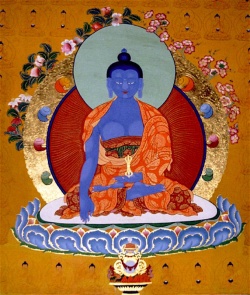Akshobhya - Buddha with Mirror-like Wisdom
Akshobhya Buddha (Sanskrit: अक्षोभ्य, Akṣobhya, "Immovable One"; Tib. Mikyopa) in Tibetan Buddhism is considered one of the five Dhyani Buddhas, the ultimate emanations of the one absolute Buddha nature that pervades everything. Alike the other Dhyani Buddha Amitabha, Akshobhya also has his own Buddha-field in the East, called the Pure Land Abhirati ('The Ultimate Joy').
According to the “Sutra of the Buddha-land of Akshobhya” (Akṣobhyavyūha Sutra), many aeons ago a monk gave strong vows to practice and teach Dharma in the Eastern Land and not feel any anger or malice towards any sentient being until enlightenment. He proved to be unshakable in his determination and became Buddha Akshobhya. In the Akshobhya Sutra, the Buddha Shakyamuni himself extolled the patience of Akshobhya in actualizing his intention so powerfully that countless beings have been saved from the intense suffering of lower states of existence.
Akshobhya is usually depicted in blue colour, symbolising the colour of clear water that reflects things as they are. Akshobhya symbolises a clear mirror-like wisdom, which can transform any anger and clean stiff feelings. No reflection in a mirror sticks to it, and none repels it. The mirror always stands imperturbable and immutable, just as we should, whether the circumstances are favourable or unfavourable to us. Akshobhya is doing earth-touching gesture (Bhumisparsha mudra)with the fingertips of his right hand. This gesture suggests confidence, deep-rootedness and determination. In his left he holds Dorje on his lap. Buddha Akshobhya may be together with his consort Lochanā and usually is accompanied by two elephants. As an elephant places its foot upon the earth with unshakeable certainty, so the Buddha Akshobhya mind reflects everything.
Buddha Akshobhya mantra is considered an effective remedy for purifying ones negative karma, somewhat similar to Dorje Sempa mantra. But the mantra of Dorje Sempa is more intended for purifying negativities related to Vajrayana practices, especially broken samayas, the tantric vows. Whereas Buddha Akshobhya mantra is very powerful for cleaning the general negative karma, and thus is very beneficial even for non-Vajrayana practitioners.
Akshobhya is the embodiment of 'mirror-like knowledge' (Sanskrit: ādarśa-jñāna;). Knowledge of what is real, and what is illusion, or a mere reflection of actual reality. The mirror is mind itself - clear like the sky, empty but luminous. Comprising all the images of space and time, yet untouched by them. Akshobhya represents the absolute Buddha Mind, and the Vajra family to which he belong is connected with reason and intellect. Its brilliance illuminates the darkness of ignorance and its sharpness cuts through confusion.
Tibetan Book of the Dead (Bardo Thodol) mentions Buddha Akshobhya is manifesting himself to the dead in after-death state (Bardo) on a second day, after the Buddha Vairochana. Bardo Thodol says the following:
“On the second day will shine a white light of a completely purified element of Water. Then from the pure blue dimension of Ultimate Joy in the East the blissful Buddha Akshobhya will appear. His body is blue and five-pointed Vajra in his hands. He is seated on an elephant throne and his wife Buddha-Lochana is with him. He is accompanied by two bodhisattvas Kshitigarbha and Maitreya, and the two Bodhisattvas, Lasya and Pushpa. Thus, only in this light will shine six forms of Buddhas. The white light of the skandha of forms (rupa-skandha in Sanskrit) in its pure dimension is the Mirror-Like Wisdom, white and shining, clear and transparent – will radiate towards you from the heart of Buddha Akshobhya and his consort…”
Here Akshobhya is associated with rupa-skandha and in his hands he is holding vajra (dorje) and the bell. When the Bardo of peaceful deities ends and begins Bardo of wrathful deities, Akshobhya-Buddha appears as Vajra Heruka. At this moment it is important to be not scared and to recognize his ultimate Buddha nature and wisdom.
The seed mantra of Akshobhya is syllable HUNG. The long version of Akshobhya mantra to purify all negative karma is:
Namo Ratna Trayaya
Om Kamkani Kamkani
Rotsani Rotsani
Trotrani Trotrani
Trasani Trasani
Pratihana Pratihana
Sarva Karma Param Para Nime Sarva Sato Nantsa Svaha
Or as Akshobhya dharani as it is sung in the video below:
Namo bhagavate Akṣhobhāya, tathāgatāyārhate saṃyaksaṃbuddhyāya. Tadyathā:
Oṃ kaṃkani kaṃkani. Rotsani rotsani. Troṭani troṭani. Trāsani trāsani. Pratihana pratihana. Sarva karma paraṃparāṇime sarva Sato Nantsa svāhā.
Source
[http://redzambala.com/buddhism/buddha-aspects/akshobhya-buddha-with-mirror-like-wisdom.html
